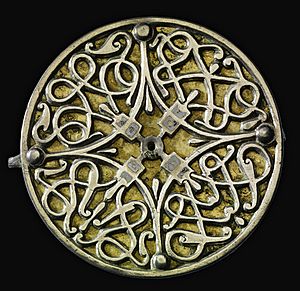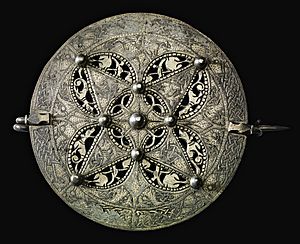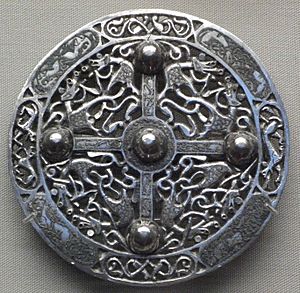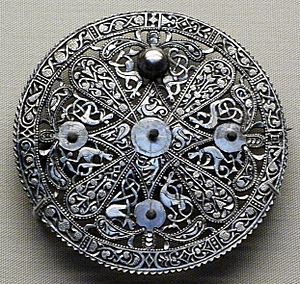Pentney Hoard facts for kids
Quick facts for kids Pentney Hoard |
|
|---|---|
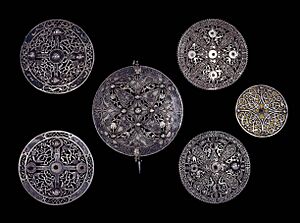 |
|
| Material | Silver, copper alloy |
| Created | Late 8th to early 9th century |
| Period/culture | Anglo-Saxon |
| Discovered | 1978 |
| Place | Pentney, Norfolk, England |
| Present location | British Museum |
The Pentney Hoard is a collection of Anglo-Saxon jewellery. It was found by a gravedigger in a churchyard in Pentney, Norfolk, England, in 1978. The hoard includes six silver brooches shaped like discs with open patterns. Five are made completely of silver. One is made of silver and a copper alloy. These brooches have special designs from the 9th century called the Trewhiddle style. Today, you can see the Pentney Hoard at the British Museum.
Contents
Discovering the Pentney Hoard
The Pentney Hoard has six round silver brooches. Five brooches are pure silver. The sixth brooch has a copper alloy base with silver on top. There are two unique brooches. These include the largest and smallest pieces in the hoard. There are also two pairs of brooches. They look similar but have different small details.
All the brooches have a cross-shaped design in the middle. The smallest brooch seems to be from the late 700s. The five bigger brooches were likely made in the early 800s. All the items are decorated with amazing detail in the Trewhiddle style. When they were found, the brooches were in excellent condition. It seems all the brooches were made in the same workshop. All but the smallest brooch had their pins and other parts still working.
Unique Brooches in the Hoard
The biggest brooch is a silver disc. It has a complex open pattern. It also has black niello (a black metal inlay) in its design. This brooch is about 10.2 cm wide. It is a great example of the Trewhiddle style. The outer edge of the brooch has eight sections. These sections show intertwined creatures. The center of the brooch has fancy animal and plant designs. The back of this brooch is plain. Its pin and spring parts are still attached. They are decorated with two animal shapes.
The smallest brooch is different from the others. It varies in size, how it was made, and its decorations. It has five rivets that connect its front to a gold-colored base plate. This brooch is about 6.1 cm wide. It has an open silver metal front. This front has simple designs of twisted plants. These designs cover a gilded (gold-covered) copper alloy backplate. The back of this brooch is plain. Its pin parts are damaged. The smallest brooch seems to be the only one that was actually worn.
Matching Brooch Pairs
Four of the disc brooches form two pairs. These pairs are not exactly identical. All four are made from silver sheet metal. They have openwork designs. They are decorated with detailed plant, animal, and geometric patterns. These patterns are in sections around a central cross shape. All these brooches originally had many raised rivets called bosses. Many of these bosses are now missing.
One pair of brooches is about 8.3 cm wide. They have wavy edges and many small beads. Each brooch in this pair has an outer band. This band is split into eight parts. These parts show plant and geometric shapes. The middle part has four rounded sections. These sections are filled with unique animals and styled plants. The backs of these brooches are plain. Their riveted pins are still complete.
The other brooch pair is about 8.5 cm wide. They have a simpler openwork design. They also have a lot of niello inlay. Each brooch has an outer band. This band has alternating sections of plant and animal carvings in the silver. The center of the brooch has a simple cross shape. It has five riveted bosses. The design is split into four sections. These sections show tangled beasts with niello inlay.
Each brooch in this pair has a plain backplate. They also have a riveted pin attached.
The Hoard's Journey Through Time
In 1978, a man named William King was digging a grave. He was a sexton for the church of St. Mary Magdalene in Pentney, Norfolk. He saw a round metal piece in the soil. As he pulled it out, he found five more metal discs. King gave these items to the church rector. The rector kept them safe in the parish chest.
Three years later, a new rector, John Wilson, found the discs. He gave them to the Norwich Castle museum. The British Museum was then asked to look at the brooches. Experts decided that the items were Anglo-Saxon silver disc brooches. The finds were declared a treasure trove. This meant they belonged to the Crown (the government). The British Museum then bought the hoard. William King, as the discoverer, received £137,000. He generously gave £25,000 of this money to the church.
In 1980, the original grave site was dug again. Metal detectors were also used. Only one silver boss was found. It was thought to be from one of the four brooches that were missing bosses. The 1980 work showed that the hoard was buried less than 1.52 meters (5 feet) deep.
Experts believe the five largest brooches were made between 800 and 840 AD. This is based on comparing them to similar brooches. The smallest brooch is thought to be from the late 700s. Some scholars think the hoard was buried in the mid-800s. This was a time when Viking raids were happening in East Anglia. Another idea is that the brooches were placed in the churchyard for a different reason. This reason might not be connected to the Viking invasion of England.
Understanding the Trewhiddle Style
The Trewhiddle style is an art style from the 9th century. It is named after the detailed decorations found on the Trewhiddle Hoard. That treasure included Anglo-Saxon coins, a silver cup, and other gold and silver pieces. The Trewhiddle style often uses silver and niello inlay. It features designs of animals, plants, and geometric shapes. These designs are often intertwined and carved with great detail into small sections.


